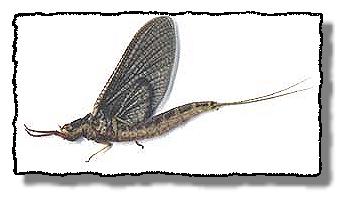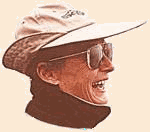|
The room had a slightly sweet tang from the remnants of the fire in the hearth. Faint
embers lit old photos of men holding up geese and ducks. Spoils of the sport. Men
in white shirts, sleeves rolled up - shotguns at rest. Pictures of labs, from pups to
elder statesmen with grayed muzzles, gazing with cocked ears from polished frames.
Vintage decoys line the hewn shelf adjacent to the fireplace authenticating the club's
heritage. Dark paneling and overstuffed leather chairs, empty now, waiting for another
season.
A private hunting club, known to members as the "Duck Club", was
our host following a casting class on the Olympic Peninsula in Washington. The club
is probably typical of a whole era of such places begun after the turn of the century.
Wonderful pieces of tradition. The Duck Club is reminiscent of another private club,
where the only interest in ducks was for their feathers.
The Pere Marquette Club in Michigan began it's existance as a gentleman's
fishing club at the turn of this century. Even then CDC flies were well known (Cul de Canard.)
Each member was assigned a cottage. All food was prepared by the staff and served in the
dining room, The Dining Shell. Women were not allowed - except for the kitchen and serving
staff. Guests of members were very limited.
Known especially for salmon and steelhead, The Pere Marquette River is
also home to large brown trout. The private water bordering the club insures members a
proper head of fish. I doubt anyone kept any.
On a mid-summer weekend, about 1970, three guests were invited to
the club. A casting class was booked. The guests were Lefty Kreh, Jim (Castwell) Birkholm
and me. It was the first time we had met Lefty. He was there to teach long-line, Castwell
and I to teach dry fly casting. We saw Lefty in action. Marveled at his strength and humor.
He is a very funny man. The classes were over and we sat around discussing the evenings
fishing.
Night's fishing is more accurate. The "Hex" was upon us. A good hex in
this case. One of the largest mayflies ever is the Hexagenia limbata.
The dry fly used to imitate it is three-inches long! Big, really big brown trout love them. But
there is a catch. The hex hatches at night. So how do you go about fly fishing at night?
That's why we were sitting around talking about fishing. Lefty listened as
Castwell and I explained how it worked. We had fished the Hex on the AuSable many times, but
this was new water, and it was going to be an adventure.

"Just as dusk is drifting in, rod in hand you set out for the river. Folks
scout the spots they want to fish while it is still light. Get into the water and make a few
practice casts. The casts are not casting practice at all, but a method of checking how far
you can cast without hitting the bushes or other obstacles. Once it's dark you won't have
a clue. If there is moonlight it is easier," I said. (White fly lines are used for this purpose.)

Castwell went on, "The next step is to listen. You can't see a fish rise.
So you make your cast by sound alone. A big gulp or galoomp upstream is your signal. Yes,
it does work. There can be other sounds too.
Like a couple of ducks spooked out of their sleep and taking off
behind you. Or a muskrat out doing his own thing. Or an owl. Or bats. Exciting stuff.
You may hear one of us fighting a fish in the dark. That could be interesting too,
especially if we lose a fish."
I finished with, "Once you have a fish hooked, the only way to know
where it is by sound - and where the tip of the rod is pointed. Big browns don't jump much,
and are more likely to head for the bottom. Or a brush pile. Certainly a challenge. Especially
when you can't see a bloody thing. A dandy trout to hand under these conditions is indeed a
trophy. Even if you release it, you do keep the memories."
|









